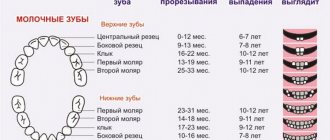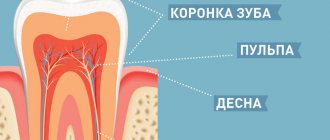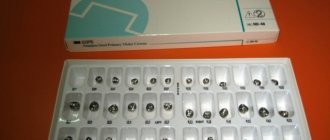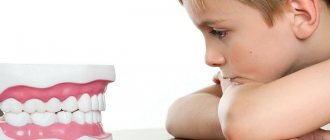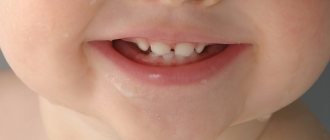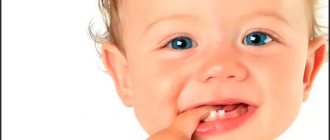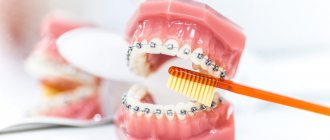In most cases, teething symptoms begin to appear at five to six months. It happens that this process begins much earlier. When the baby behaves restlessly and loses his appetite, parents begin to think whether babies can start teething at 3 months, or whether this behavior is caused by other factors. Here you need to understand that all babies develop according to an individual schedule, and such a situation is quite likely.
The child has two visible teeth
What to Expect When Teething
Symptoms of eruption of baby teeth in infants at 3 months can be as follows:
- The gums are inflamed and swollen;
- The child begins to drool heavily;
- The baby puts into his mouth everything that comes to hand;
- The baby loses his appetite;
- The baby's sleep becomes superficial, he often wakes up in a bad mood and cries loudly.
How can you tell if your baby is teething at 3 months? The baby is often capricious, looks overexcited, constantly asks to be held, and attracts attention. In addition, he has a negative reaction to harsh sounds and bright lighting. You may also experience frequent mood swings.
Signs of teething in a 3-month-old baby may also be similar to a cold or a malfunction in the digestive system. The baby may develop snot and cough, and the temperature may rise. You can also observe excessive regurgitation, hard or liquid stools, and rashes on the cheeks.
Note! Not all signs appear at the same time. One child may have a fever or bowel movements, while another may simply have increased salivation.
baby crying
Decreased immunity
As children develop teeth, their immunity decreases. Children become weaker and more susceptible to the effects of various microbes and pathogenic bacteria. Excess saliva may cause a cough. In this case, it will be wet, not very frequent, and may intensify when the baby lies down. If the cough is strong, obsessive, and makes it difficult for the baby to sleep and eat, most likely an infection has entered the little body.
Important! If you have difficulty breathing and shortness of breath, you should urgently show your baby to the doctor.
When teeth appear, babies often develop nasal discharge, which goes away within 3-4 days. Normally they are transparent and liquid. When the infection enters the body, it turns yellow or green in color.
A slight increase in body temperature (up to 37-37.5 degrees) is normal. It is easy to bring it down with any antipyretic agent, it returns to normal on the third day. With acute respiratory infections, the temperature rises to 38.5 degrees and lasts longer.
In addition to decreased immunity, alarming symptoms may appear that require urgent intervention:
- The child completely refuses to eat (hasn’t eaten for more than 12 hours);
- The baby has persistent diarrhea, which may be a consequence of an intestinal infection;
- Clots of blood and mucus were found in the stool;
- The baby cries very loudly for more than two hours.
If nasal discharge appears, it is necessary to rinse the nasal passages
Timing and sequence
Signs of teething in a 4 month old baby
All children develop teeth on their own individual schedule. If parents are concerned about the question of whether a baby can cut teeth at 3 months, then the answer is yes. In many children, the first teeth can be seen at 6 months. It happens that they begin to emerge very early (at 3 months) or late (at 10-12 months).
Additional Information. If the baby is already one year old and does not yet have a single tooth, you need to contact your pediatrician. You may also need to consult a dentist to determine the presence of developmental pathology.
Standard pattern for the eruption of primary teeth in the lower jaw
| Name of teeth | Timing of eruption |
| Central incisors | 8-12 months |
| Lateral incisors | 9-13 months |
| First molars | 13-19 months |
| Fangs | 16-22 months |
| Second molars | 2-3 years |
Standard pattern for the eruption of primary teeth in the upper jaw
| Name of teeth | Timing of eruption |
| Central incisors | 6-10 months |
| Lateral incisors | 10-16 months |
| First molars | 1.5-2 years |
| Fangs | 1.5 years |
| Second molars | 2-3 years |
Additional Information. If babies cut their first teeth at 3 months, these should be the front incisors. If the molars appeared first, a consultation with a dentist is necessary to find out if there are any pathologies.
First teeth
The timing of the appearance of the first milk teeth in a baby
Undoubtedly, this time is considered alarming for many parents - sleepless nights combined with the whims of the baby, sudden mood swings and changes in physical condition. These moments are difficult for everyone, especially for mother and child. But how can you try to change something for the better and make your baby’s life easier? Of course, there are no guaranteed ways that can completely avoid the negative symptoms of the appearance of the first teeth, but minimizing them is a completely doable task.
The most important thing to note right away is that there is no exact timing for teething. For each child, the onset of this period is completely individual. Moreover, even if you have twins, this does not mean at all that their teeth should erupt on the same day.
Of course, there are statistics that teeth mainly make themselves felt around 6 months after the birth of a child. At about a year old, a baby usually already has about 6-8 teeth. However, their complete absence is quite acceptable, provided that there are no preventing reasons.
Thus, the process and order of teething is completely unpredictable, since it depends on many external and internal factors. Noting the peculiarities of the timing of the beginning of the period, this parameter varies under the influence of various indicators:
- climatic conditions
- genetic background (heredity)
- the presence of various diseases, in particular the endocrine system
- nutrition, drinking water quality
- proper child care and others
Speaking about delayed teething, there is a direct connection with a general delay in growth and development, which can be observed with the following pathological abnormalities:
- Rickets is a disease of infancy that develops against the background of insufficient intake of vitamin D into the body, which interferes with the absorption of calcium, an essential element for the development of teeth (for more details, see the article signs and treatment of rickets in infants)
- edentia - the absence of tooth rudiments; the presence of this disease is checked by x-ray or radiovisiograph.
Before erupting, teeth go through the stage of formation and formation of dental buds in intrauterine development from approximately 6 to 7 weeks of pregnancy, when many expectant mothers are not yet aware of their interesting position.
If teeth erupt late
Teething gum gel for babies
Often, inexperienced parents, having noticed signs of the appearance of the first dental units in the baby, begin to worry about whether an infant can cut teeth at 3 months. Also, many mothers and fathers are worried that their 6-month-old baby does not yet have a single tooth.
Teething in a newborn is influenced by factors such as:
- Development of rickets;
- Weakening of the immune system;
- Failure of the endocrine system;
- Unbalanced diet, late complementary feeding;
- Prematurity;
- Insufficient amount of calcium in the body;
- Problems in the functioning of the gastrointestinal tract;
- The rudiments of baby teeth are missing.
Teething baby
Are early teeth normal or pathological?
Pediatrics has repeatedly encountered situations where newborns, during their first examination in the delivery room, suddenly discover one or even several teeth. This individual feature of the body must be under the control of a dentist. If the teeth have taken their designated places and will not interfere with the proper development of their “neighbors,” then it is recommended to simply monitor them periodically. Additional teeth that extend beyond the row are removed.
Can the first teeth cut at 2 months? Of course they can. Early teeth are the reason that the expectant mother diligently replenished the reserves of calcium and vitamin D in her body. Having accidentally discovered a small white spot on the gum of a two-month-old child, you should not panic and look for some kind of anomaly. But it is also not recommended to ignore such an important factor. Therefore, it is advisable to still show the baby to the dentist.
How to relieve a baby's condition
Why does a one-year-old child have no teeth - timing of appearance
Parents should know how to understand that a baby is teething at 3 months old, and help him easily endure this process. A high temperature can be brought down with the help of antipyretics. Frequent breastfeeding and carrying the baby in your arms will also help. Another good way to relieve pain in your gums is to smear them with a special anesthetic gel. To distract your baby, you can read him a book or show him a cartoon.
When your baby's gums itch and he puts everything in his mouth to scratch them, you should offer the baby a cooled teether with gel. Instead of toys, you can give your baby chilled pieces of apple or carrot.
Important! It is worth paying close attention so that the baby does not accidentally bite off a piece and choke on it.
Baby chews on a teether
How to help your baby?
Ailments characteristic of the teething period significantly complicate the life of the baby and his parents.
The child feels pain and discomfort, so he is constantly capricious and cries, sleeps little and eats almost nothing.
For parents, such difficulties in caring for their baby result in double stress, since they are caused not only by fatigue, but also by a feeling of anxiety for the child. There is a natural desire to help the baby.
In such cases, doctors' recommendations are to reduce the child's pain. For this purpose, special anesthetic drugs are used, for example, anesthetic gels.
The product is applied directly to the baby's gums.
If teething is accompanied by an increase in temperature, then it is better to give the child dual-action drugs - to simultaneously reduce both temperature and pain.
Such drugs include drugs based on ibuprofen or paracetamol - Panadol, Nurofen, etc.
These products are available in the form of fruit-flavored syrups that are well received by even the youngest children.
An alternative option for pain relief with a fever-reducing effect can be suppositories, for example, Dantinorm Baby.
READ Symptoms of wisdom tooth eruption
If taking medications is contraindicated for your baby, then it is better to turn to the advice of traditional medicine:
- Give the child a light gum massage. To do this, wash your hands thoroughly and, without pressing on the gums, massage their surface with stroking movements;
- cold dulls the feeling of pain. Chewing a cotton napkin soaked in cool water or chamomile infusion can reduce pain and alleviate the baby's condition.
Teething makes a child want to constantly chew on something.
Special teethers and elastic rings made of harmless materials - silicone, gel or rubber - can help your baby. To improve the effect, the teething ring is pre-cooled.
Problems arising with the first teeth
Your baby's first teeth may take on a gray tint. This happens if the mother took iron supplements during pregnancy. This may also be due to the fact that the child has chronic inflammatory diseases in his body. It happens that milk teeth become yellow-brown. This happens after the mother or child takes antibiotics.
If the teeth have acquired a yellow-green color, it is worth conducting a blood test, as its diseases are possible. Due to congenital disorders in the metabolism of porphyrin pigment, a child’s teeth may become red.
Factors affecting tooth growth
The following factors may influence whether a child can erupt his first teeth at 3 months:
- Baby's genotype;
- Proper functioning of the thyroid gland;
- Floor;
- Past severe infectious and viral diseases;
- Duration of breastfeeding;
- Presence of congenital diseases.
According to many dentists, it is normal that a child’s first teeth appear at 3 months. If they came out earlier, this already indicates an imbalance of hormones in the baby’s body and requires adjustment.
